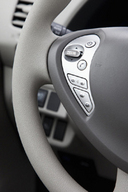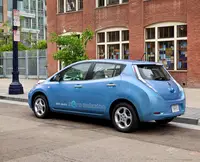2011 Nissan Leaf: The Automobile of Future, Today - VIDEO ENHANCED REVIEW
Make Me Smarter: Nissan Buyers Guide
By Marty Bernstein
Senior Editor Detroit Bureau
THE AUTO CHANNEL
Lewis Mumford, a noted urban critic of the last century wrote, “Our national flower is the concrete cloverleaf” to which must be added “that has grown and flourished with millions of vehicles powered by gasoline. America’s love and dependence on the gasoline powered automobile has, for over a century, created huge industries, provided untold millions of jobs and a world of easy and convenient transportation few people could have imagined.
But now, as everyone knows, our planet is, depending on one’s point of view, either in the midst of an economic, environmental and ecological disaster or not. I’m not here to debate this issue. My job is to review the 2011 Nissan Leaf, the first modern electric car than is an answer to the issues just tendered and for the greater part has been created in response to government mandated and legislated environmental changes.
All these equivocations and discussions duly noted, this is a truly amazing vehicle deserving of praise for what it has accomplished. Buzz Lightyear will remember the Leaf as his generations’ equivalent of Ford’s Model T. A lengthy list of details, facts, issues and is detailed in the sections that follow.
Description of the Leaf
This is not a science project. It’s a real car. A well designed
medium-size hatchback that does not have a traditional internal combustion
engine and attendant components – muffler, tailpipe, radiator, etc.
-- uses no gasoline, emits nothing noxious, is very quiet and can, if
needed the company says can hold five people. Ah, but you still have a few
questions, right? Here are a few I believe are relevant.
Click PLAY to watch Leaf on-road video
Exterior Style & Design Notes
This is a nice looking vehicle with smooth aerodynamic design surfaces
that start from the low, compact hood, moves through the sides and on
toward the large rear spoiler. The Leaf’s exterior styling statement
begins with a sharp, upright V-shaped design featuring up-slanting LED
headlights which split and redirect airflow away from the door mirrors,
reducing wind noise and drag. In the rear, the slim-type aerodynamic LED
taillight design combine with the aerodynamic muffler-less rear bumper with
rear diffuser to manage the aerodynamics of the rear end without
compromising rear interior roominess.
To add aerodynamics and reduce noise the Leaf has a flat underbody cover to manage airflow under the vehicle. An vortex-shedding roof-mounted antenna is utilized to help reduce wind noise. Other noise reduction features include a quiet-operation windshield wiper motor, a sound insulation windshield design and a dual-isolated motor-mounting system.
 Nissan Leaf interior |
Interior Design, Space and Materials
For a relatively small car the Nissan Leaf is surprisingly roomy and
actually quite good looking in a high-tech, utilitarian manner. The front
bucket seats are comfortable as are 60/40 split folding rear seat with not
too much leg room. The seat fabric is made with partially recycled
materials. Recycled materials are also used for the back door trim, roof
trim and headliner, carpeting and a number of other interior pieces such as
the door panels and center console storage cover. Only one interior color
is offered at the present time, Light Gray.
 Nissan Leaf steering wheel |
Hi-tech gages and devices aid in driving
As befitting the first modern electric vehicle, the drivers information
– instrument panel is a knock-out of sophistication but easy to read
and use. The digital “eyebrow” display at the top of the
instrument panel provides high visibility for the Eco indicator and
speedometer, while the lower liquid crystal meter display houses the power
meter, battery temperature gauge, multi-function display, remaining energy
gauge, capacity level gauge and distance to empty display.
 Nissan Leaf instrument panel |
The center console area includes the palm shifter (inspired by a PC mouse) for the “by wire” drive selector. The 3-spoke steering wheel has controls for the cruise control, audio system and standard Bluetooth® Hands-free Phone System. XM® Satellite Radio (XM® subscription required, sold separately) is also standard, with HomeLink® Universal Transceiver standard on Nissan LEAF SL models.
 Nissan Leaf Infotainment |
The flat panel console cluster includes a lare color monitor for the standard navigation system, available RearView Monitor and control of the audio and climate systems. The display also provides access to Nissan’s Carwings telematics system, which is connected to a global data center, (subscription required, no charge for 36 months). Using this system Nissan LEAF drivers are able to use mobile phones to turn on air conditioning and set charging functions remotely, even when the vehicle is powered down. The system also displays “reachable area,” as well as showing a selection of nearby charging stations. An on-board remote-controlled timer can also be programmed to recharge the batteries.
Are there safety features and devices?
Standard Nissan LEAF safety systems include:
• Nissan Advanced Air Bag System (AABS) with dual-stage supplemental front air bags with seat
belt and occupant classification sensors
• front seat-mounted side impact supplemental air bags
• roof-mounted curtain side impact supplemental air bags for front and rear-seat outboard occupant head
protection
• 3-point ALR/ELR seat belts (driver’s seat ELR only) with pretensioners and load limiters
• child seat upper tether anchor, LATCH (Lower Anchors and Tethers for Children) system and child
safety rear door locks
• Vehicle Dynamic Control (VDC) and Traction Control System (TCS) are also standard on all LEAF models.
What makes it go?
In techno speak the Nissan LEAF is powered by 48 laminated compact
lithium-ion battery modules and a high-response 80 kilowatt alternating
circuit synchronous motor that generates 107 horsepower and 207 lb-ft of
torque. Turn the key, push a button and the Leaf is fully powered, albeit
quietly from the get-go.
How far will it go?
When fully charged (more about that later) the Nissan Leaf has a range
of 100 miles, which the company notes satisfies the average of 50 miles the
distance most people who commute by car currently drive. The actual
distance will vary depending upon: • Climate as extreme temperatures
– high or low – will use more energy to heat or cool the
vehicle. • Speed like gasoline powered cars, the faster one drives
the more energy in this case is used. • Driving styles – smooth
or aggressive – will extend or decrease the driving range
 Nissan Leaf home charging station |
Battery charging and costs
The Leaf can be charged with 110, 220 or 440 volt currents, but the
company notes the home-charger will be essential. As a result part of the
buying experience is the visit of a Nissan approved contractor who will
estimate the cost of adding a charging station to the owners garage.
 Nissan Leaf charging port |
Additionally Nissan dealers in the five regions where the first Leaf’s are being sold have charging stations already installed. Other outlets are being developed at supermarkets, shopping centers, office buildings and other private and public venues. That noted, the infrastructure will take some time to reach its goals. Frankly, there aren’t that many in public operation but Nissan has detailed visionary plans for building 10,000 charging stations over the coming years a distribution of the Leaf expands.
The driving experience
Plainly, providing a highly responsive, fun-to-drive experience that is
in keeping with what consumers have come to expect from traditional,
gasoline-powered vehicles. It’s really fun to drive, responsive,
agile and nimble for in-city driving as well as on the road. The Leaf is
exceptionally quiet, so quiet there has been some movement for it having an
audible warning when parked at a stop light or sign. The power is instant.
From 0 to 60 in less than :10-seconds and even higher when pushed –
and I pushed – when entering an expressway up to the maximum speed of
90 mph.
What does it cost and where can it be bought?
Nissan is first rolling out the Leaf in five regions – Portland,
OR, San Diego, CA, Phoenix, AZ, Hawaii and Eastern TN, with more regions to
follow in the weeks and months ahead as supply catches up with demand for
the futuristic car. Deliveries are currently rather slow. There are 3
models of the Leaf, the variance is in charging time, with a starting price
of $32,780 minus the $7,500 tax incentive now available.
Is the Leaf for you?
Naturally that's a question I’m unable to answer. Given the
cutting edge, green technology of the Leaf many will see it as a good
ecological investment especially with a $7,500 Federal tax rebate. I
predict it will be the second or third car in most households except for
those who live in major cities where it will be a great car to maneuver
around and park in small places. There are those however who regard the
entire collection alternate fuel vehicles be they electric, hybrids and
their many variations as not necessary to protect the environment. Where
you fall determines you interest and need.
No matter what you drive, our national flower, the concrete cloverleaf, is here to stay.
Click PLAY to watch the Nissan Leaf presentation at Plug In 2009
